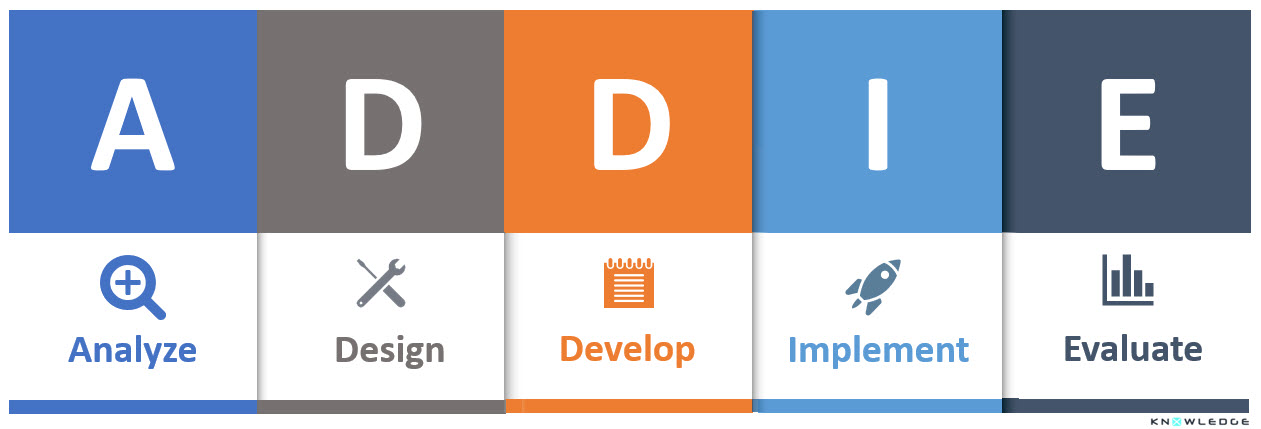ADDIE Model
ADDIE is an instructional systems design (ISD) framework was devloped in the 1970s, used by many instructional designers and training developers. The framework is used to help in the productions of learning content. It was first used by Florida State University in 1970s ffor militry interservice training design, though the orign of the model remain to date obscure.
The five phases represent a dynamic and flexible guideline for building training and learning support interventions. The ADDIE acronym stands for Analyze, Design, Develop, Implement and Evaluate.

Analyze
The analysis phase of the ADDIE model is known as the data-gathering phase. During the analysis, the following need to be identified:
Instructional goals; you will need to identify whether the gap is caused due to a lack of knowledge or skills? Identify all constraints that could impact achieving the desired goals. Now, state the overall objectives, goals and the desired outcomes.
Target audience; identify the experience level, competency level required for the targeted audience, preferred language, audience demographics and current level of motivation.
Required resources; define the suitable learning intervention, best technologies, budget and resources that can be utilised.
Below are some of the useful questions that could help during the analysis phase:
- Who is the audience?
- What are their characteristics?
- What is the desired new behaviour?
- What types of constraints you could be facing?
- What are the available delivery options/platforms?
Design
The design phase of the ADDIE model should be systematic and specific. During this phase, you may consider the following:
Learning Objectives; define specific, measurable actions that will enable learners to fulfil desired goals.
Instructional design; establish clear links between the content and learning objectives. Design and arrange the content and learning activities in a logical sequence that supports the learners' journey.
Learning outcomes; design exercises, assessing progress activities, the desired evaluation level and methods, and the tools to be used to measure the desired learning outcomes.
Develop
The development phase of the ADDIE model is where instructional designers develop the solution, also known as the longest phase and more project time-consuming phase. During this phase, you will be working on:
Learning content; the actual content and learning material outlined in the design phase such as; visual materials, facilitation guidelines, exercises and learner workbook.
Validation; visit the stakeholders to discuss, review and validate the resources developed and learning content.
Pilot Test; It is wise to run pilot testing to ensure all the deliverables are met. Collect feedback towards the final adjustments that should be carried before moving to the implementation of the learning solution.
Implement
During the implementation phase of the ADDIE model, your product will come out to live. The following to be carried during this phase;
Preparation; the lead instructor for the course identifies and schedules, qualified individuals to act as facilitators, and take part in the train-the-trainer process.
Participants engagement; begins with scheduling, followed by notification, enrolment and then the delivery of the solution.
Evaluate
During the evaluation phase of the ADDIE model, feedback and data are collected to identify the impact on the defined levels of evaluation and define any areas that require improvement. This will later feed into the design of the solution.
There are two types of evaluation;
Formative evaluation; conducted before the implementation to determine whether the quality of learning resources satisfies the standards established in the design phase.
Summative evaluation; conducted after implementation of the solution, and generally defined at three levels.
Level 1: satisfaction, which measures the degree of participant’s satisfaction and happiness with the solution. It is focused on participants feelings, preception and happiness in regards to visual content, venue, and facilitation.
Level 2: Learning, measures the acquisition of knowledge and skills.
Level 3: performance, measures the newly acquired knowledge and skills transferred into the actual work environment.
ADDIE Model Pros & Cons:
Pros: ADDIE is commonly used and is a foundation for other models. It is flexible, simple and can be used for various instructions across many industries. The ADDIE model can be easily adapted to evaluations and common measuring criteria.
Cons: ADDIE is mostly a linear process, which means that each stage must be completed before starting the next stage. The model can be time-consuming and costly as setbacks and changes take more time to redo compared to more agile programs.

Comments
No Comments added, be the first...